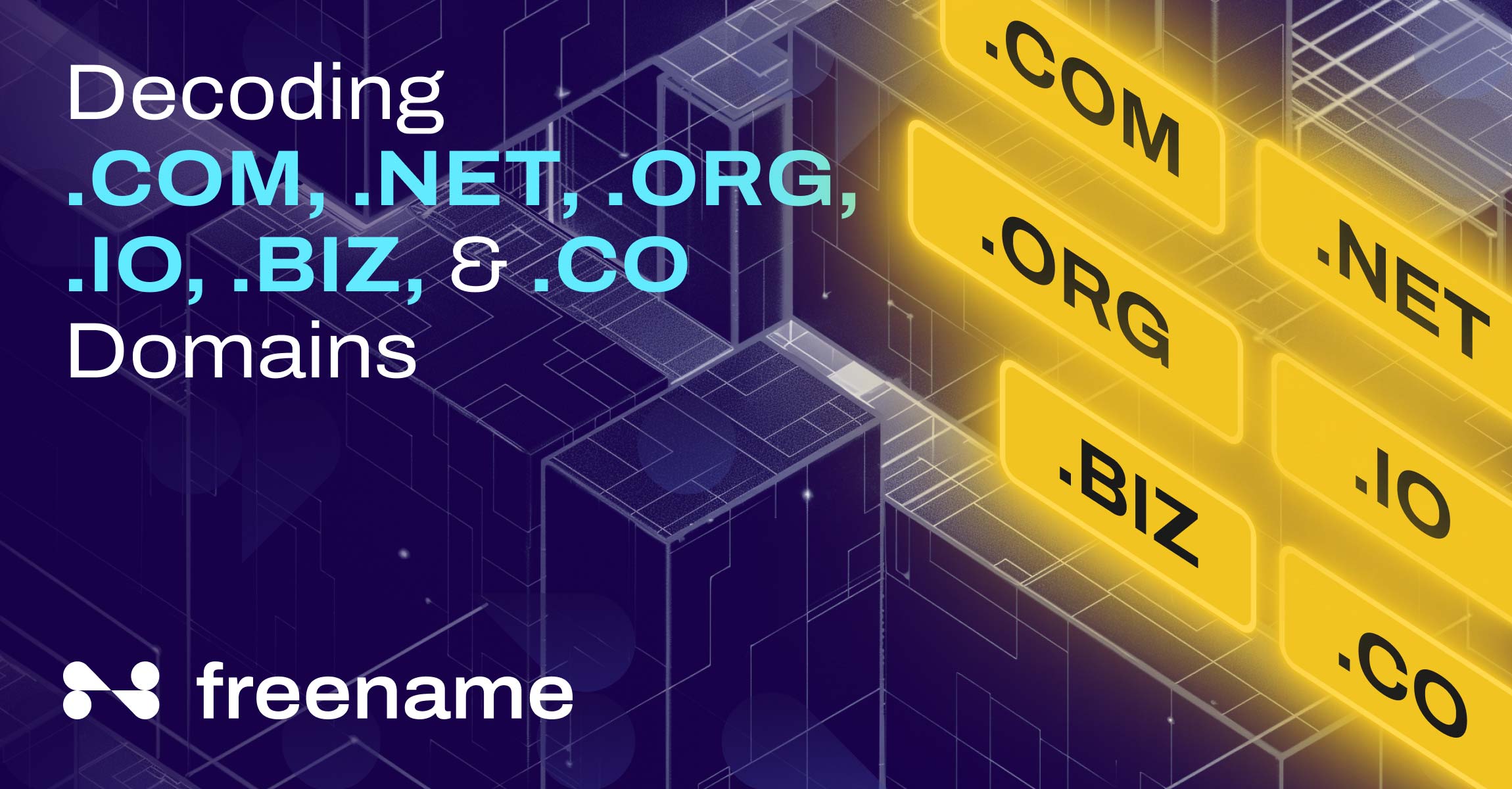You have a handful of domains, like .com, .net, .org, .biz, .io, .co, etc., to choose from. Yet, you can’t decide which domain extension meets your business objectives.
Picking the right option for your brand and business can be overwhelming unless you know the significance of each option. It becomes even more important when you’re buying domain names for the purpose of reselling.
These domain extensions vary in terms of quality, security, data privacy, profitability, and reach. So, if you have questions like, ‘What is .com?’, ‘What does ORG mean?’, or ‘What is the difference between .com and .net?’, this post is for you.
Here, you’ll find all the necessary details related to the most popular top-level domains (TLDs), .com, .net, .org, .co, .io, .biz, etc. Also, we’ll share an in-depth comparison between .com and other TLDs, highlighting the benefits and drawbacks of each.
.COM vs .NET vs .ORG vs Other TLDs
| Top-level Domains and Extensions | Domain Count |
| .COM | 154 million |
| .NET | 12.43 million |
| .ORG | 11.06 million |
| .CO | 3.36 million |
| .BIZ | 2+ million |
| .IO | 1.6 million |
What is .COM?
.COM domains need no introduction, and rightly so. Whether it’s Google, Facebook, Instagram, YouTube, or any other popular website in the world, they all have one thing in common — they’re all .com domains.
This is the reason why .com is known as the ‘King of domains’. According to DomainTools’s research, the .com domain count has nearly 50% share of the total number of registered domains.
Currently, more than 154 million online platforms contain .com extensions. In comparison, .de holds the second spot with just over 17 million domains.
But what does .com stand for? Let’s find out.
What Does .COM Mean in a Web Address? How to Use It
.COM is one of the first six generic top-level domains (TLDs) ever created. It was created in January 1985 and got its first registered domain (second-level domain) in March 1985. The domain was Symbolics.com.
In general, TLDs are located at the extreme right of a web address as a parent domain, while SLDs are located before the dot. It’s the easiest way to recognize what TLD a domain name belongs to.
Now, coming to the question, “What does .com stand for?”
The word ‘com’ indicates ‘commerce’, so the domain was intended for businesses and commercial organizations. However, it’s a different story nowadays.
Anyone, from commercial businesses to non-profit organizations and even individuals, can use this domain for their unique purposes.
Pros and Cons of using a .COM Domain
If you’re new, .com should be your first preference because:
- It has been ruling the internet domain industry for almost four decades.
- It’s trustworthy
- Everyone is familiar with it — nothing shady
- Holding more authority than other domains, .com is the best choice for ranking on search pages, regardless of the search engine.
- It takes your business across the globe
Now, let’s face the reality.
As we mentioned earlier, the TLD has grabbed almost 50% of the market share. So, it’s most likely that the domain name that meets your objectives has already been taken. And if you intend to buy the name from the marketplace, be prepared to pay a hefty price.
Moreover, consider the price hikes. The wholesale price of the domain rises with time. This means after 10 years, the same domain will cost approximately 70% more than what it costs today.
.COM Alternatives
Think about .com alternatives that still have your targeted domain name available. If the name’s already taken, chances are that the price tag won’t be as expensive as that of the .com TLD.
So, what are your options?
- Try geographic or country code TLDs: TLDs like .us, .ae, .uk, etc., play a significant role in promoting businesses, services, and projects at a regional level.
- Use other generic TLDs: You can always check out other popular generic TLDs like .net, .org, .biz, .io, and .biz to see if your intended domain name is available.
What Is .NET?
.NET domain is another generic TLD created in 1985. Any guesses about what it was meant for? If your answer is ‘networking’, you’re right.
Primarily, the domain was meant for infrastructure and network organization. If you own a web technology company, the .net domain will be the best choice.
However, with the inclusion of new businesses, the demand for .net domains increased and went beyond its original purpose. Today, anyone can get registered under this TLD.
What Does .NET Stand For?
Most of the people still believe that .net domains are targeted at social media networks. However, this is a misconception.
The original meaning of .NET is ‘Network’. So, this domain was meant for multinationals whose offices are located in different parts of the world.
This generic TLD serves as an excellent alternative to the .com TLD since most of the .com domains have already been taken.
Pros and Cons of .NET
One major advantage of the .net TLD is the availability of domains. Although the .net domain count has surpassed 12.4 million, there’s still a lot of room to acquire the perfect domain name for your business.
Market leaders like Behance.net use this domain to link creatives with companies in search of creative professionals.
It’s a go-to TLD for building email platforms and web apps, but it may not be a good choice if you wish to build a portfolio, collection, or online store.
.COM vs .NET
If you compare .net vs .com, the latter seems more feasible for individuals as well as commercial organizations. However, the .net can separate an infrastructure company from the lot, giving it a more professional outlook.
That said, there’s no big difference in terms of technical attributes. You can use either one for your unique purposes.
What Is .ORG?
.org is another generic top-level domain that you can choose as an alternative to .com. Being part of the original TLDs created in 1985, this domain would serve as a virtual real estate for non-commercial organizations or entities that didn’t fit anywhere else.
The .com vs .org comparison shows that the latter had a slower growth initially. There were less than a million .org domains in the 1990s.
The growth accelerated during the period 2000 – 2012 as the number of .org domains rose to ten million. Since then, it has been held steady. As of 2024, there are around 11 million .org domains worldwide.
What Does .ORG Mean?
The word ‘ORG’ means ‘organization’. When this domain was created in 1985, it was tailored for non-profit organizations, charities, and fundraising campaigns. However, things have changed in 2019.
Now, as the restrictions have lifted, everyone can get registered under the .org domain. The only difference between .com and .org extensions is that most .org domains belong to non-profit organizations, NGOs, open-source projects, etc.
It’s an excellent domain for charity, cultural art or social websites with no intentions to buy or sell.
Benefits and Drawbacks
If you belong to any non-profit niche or want to establish a charity website, .org is an excellent choice. Some of the most popular websites containing the .org extension include:
- World Wildlife Fund – www.worldwildlife.org
- UNICEF – www.unicef.org
- Wikipedia – www.wikipedia.org
- Greenpeace – www.greenpeace.org
Although there are no restrictions on the use, building a profit-driven website on a .org domain can be misleading. Moreover, there’s always a risk of potential price inflation.
What Is .CO?
Most people are not aware of what is .co vs .com because of the close resemblance. If you’re one of them or believe that .co is a short form for .com, this section is for you.
The .co domain doesn’t belong to the elite list of generic TLDs launched in 1985. It was created to serve local and regional businesses in the Columbian territory.
However, today, it’s a worthy opponent for a .com vs .co fight because of the similarities in spellings. Since 2010, more than two million .co domains have been launched in over 200 countries.
What is the meaning of .CO? How should .CO be used?
Most of the two-lettered domain extensions are country-specific. So you have the right to know what country is .co.
Initially, .co was reserved for businesses and organizations operating in Columbia. However, it became open for all back in 2010.
If you’re unable to find a domain name with the .com extension or if it is too expensive, the .co extension would be the next best thing.
.CO Domain Pros and Cons
Let’s answer the burning question, “Is .co a good domain?”
The latest statistics show that the .co extension isn’t as popular as .com. It’s a good sign for newbies and starters as they have a relatively bigger pool of domain names to choose from – and that at a reasonable price.
- It offers a lot of options to create a short and memorable domain name according to your objectives.
- It’s not country-specific and is relevant for all businesses — profit or non-profit — and individuals.
- You can create open-source projects using the .co extension
Did you know that lots of popular websites with the .com domains have acquired the .co domains as well? Take a look at the following:
- Amazon.com: Amazon has a domain name, ‘a.co’, that redirects users to amazon.com.
- Google uses g.co to redirect users to Google.com
- Snapchat utilized s.co for a similar purpose.
The downside of using the .co domain is that non-savvy users may not perceive your website as a trusted platform. Moreover, as most of the users are only familiar with the .com extension, they might add the missing ‘m’ in the end and land on the wrong website.
What Is .IO?
.io is a country-code TLD managed by a domain name registry service called Internet Computer Bureau LTD. This TLD has an interesting history:
- This TLD was created in 1997 by the Internet Assigned Numbers Authority (IANA)
- Initially, it was assigned to a British entrepreneur, Paul Kane, from Internet Computer LTD.
- The first subdomain registered under the .io TLD was levi.io (registered by Levi Straus & Co.) in 1998.
- In 2017, Kane sold this TLD to a private domain registry service, Afilias for over $70 million cash.
- In 2020, the domain was sold to Donuts for a handsome amount (sum undisclosed).
- In 2021, territorial disputes between the United Kingdom and Mauritius impacted the domain’s ownership.
Over the years, the .io domain has seen a lot of commercial success. It is considered to be the most popular domain in the Web3 space and has been acquired by various crypto companies. There are more than 270,000 domains registered under the .io TLD.
But what does .io mean? Let’s take a deep dive.
What Does .IO Stand For?
.io extension is a a country code TLD that represents “Indian Ocean”. It was operated by Internet Computer Bureau during the period 1997 – 2017 before it was sold to a private business.
This TLD attracts computer enthusiasts. The name ‘IO’, is commonly associated with Input/Output functions. Therefore, this domain garnered special attention:
- Software houses
- Web development firms
- Digital marketing agencies
- Programmers and coders
- Designers
- NFT collectors
- Domain investors
- Data scientists
- Hackers, etc.
.IO Pros and Cons
The major reasons behind the popularity of the .io TLD include:
- The .com vs .io comparison shows that the latter has a lot of room and space to acquire. It is more likely that the domain name you’re looking for is available.
- This TLD is shorter than other generic TLDs, so it’s easier to remember.
- The domain extension has a special attraction for developers and coders. In fact, most of the open-source projects on the web have been registered under .io domain.
- Lots of popular businesses have the .io extension, e.g., Freename.io, Github.io, Etherscan.io, and Greenhouse.io, etc.
One major difference between .com and .io TLDs is that the .com TLD is more popular. It carries trust and has a better ranking tendency than any other TLD.
What Is .BIZ Domain?
.biz domain extension is relatively younger compared to .com, net, .org, and .io TLDs. It was created in 2001 specially for commercial businesses who couldn’t find a proper .com domain extension for themselves.
As of 2023, there were 1.4 million domain names registered under .biz TLD.
What Does .BIZ Stand For?
As the name suggests, BIZ means ‘Business’. The TLD was created to facilitate businesses that were unable to occupy a .com real estate due to the unavailability of relevant domain names.
Also, the word ‘BIZ’ indicates reliability and trust, so the intention was to provide end-users complete satisfaction with legitimate and authentic businesses.
For boasting businesses, launching new products, and promoting services, .biz TLD offers a massive pool of resources. Considering that the .com marketplace is nearly saturated, featuring skyrocketing domain prices, .biz is a sensible option for starters.
.BIZ Domain Pros and Cons
While competing with the .com domains, .biz domains have to face stiff competition. Anyhow, the TLD offers far cheaper domains, making it easier for individuals to launch their products and services online.
The most popular .biz sites include:
While .biz is not as popular as .org, .net, .co, and .io, it offers a more professional feel. Plus, there are higher chances of acquiring relevant domain names at cheaper prices.

Freename Domains for Web3 Space
The above-mentioned TLDs have been quite popular in the traditional Web2 space. However, these domains still lack the level of security and privacy associated with blockchain-based domains.
- Apart from higher price tags, web2 domains are not permanent. Owners have to renew their web2 domains every subsequent year, which can be a burden.
- In contrast, not only are Freename’s web3 domains are cheaper, but they’re also permanent in nature. You only have to pay once to own a domain, and that’s it.
- The web2 webspace is being controlled by a limited number of entities. They devise policies and plans that domain owners must follow in order to keep their websites operating. There is no such issues in the decentralized domain space as the ownership is restored with the owner, and decision-making is done by the network users.
- Web2 space offers protocols and gateways that often cause hindrances for the users. For example, online transactions are being overseen by intermediaries and third parties, which results in disclosing personal information. Web3 space offers P2P access, which means personal information remains safe.
Because of these major differences, a large number of web2 sites are switching to the web3 space. With a high level of privacy and liberty to launch anything worth sharing, web3 space offers an ocean of opportunities to aspiring entrepreneurs and creative minds.
You can start your web3 journey with Freename, a renowned web3 registrar and DNS provider. Not only can you purchase second-level domains, but you can also buy your own TLDs at fairly reasonable prices.
Web3 TLDs offer a passive income opportunity. When someone wants to get registered under your TLD, you’ll get a handsome commission. With Freename TLDs, you can earn up to 50% commission everytime when a new domain is listed under your TLD.
FAQs
Among .com, net, .org, .co, .io and .biz, which TLDs are more popular?
- .com is an uncrowned king in the domain industry.
- .net is the second-best TLD for businesses and individuals looking to get international traction.
- .org domains have significantly grown in numbers since 2012
- .co is a good alternative for businesses seeking .com domains
- .io and .biz may be far behind, but they’re pacing up.
Which TLDs offer better ranking opportunities?
Any domain can be successful and get a high ranking on SERPs. You need to follow Google’s International Guidelines to improve your domain’s ranking in different regions.
Between .COM and .ORG, which is the most trusted domain?
When it comes to reliability and trustworthiness, both TLDs are equally placed. However, if you have a commercial business, you should prefer .com over .org. If you’re launching a non-profit website, then .org is the best choice.
Which is better: .COM, .NET or .ORG?C
Most would say ‘.com is better.’ But it depends on the business or personal website being launched. .net would be more suitable for launching a new social network. If it’s a charity organization, then .org is a better choice.
What country is .CO?
Initially, .co was meant for the “Columbia” region. But now, this TLD has a long list of domain names from over 200 countries around the world.
What is the difference between .US vs .COM?
.us is a country code TLD with over 2.2 million domain count. It is best suited for businesses operating within the United States. On the other hand, .com is a global term with over 154 million domains under its belt.
Are .CO and .COM TLDs Similar?
They do look similar (only ‘m’ is missing from .co) but there is a difference between .co and .com. The .co TLD was launched as a country code TLD targeting Columbia, while .com was meant to be used by commercial businesses across the globe.
Now, with skyrocketing demand for domains, many TLDs have been used for different purposes. .co is still far behind .com in terms of domain count. But it offers a massive pool of domains with cheaper price tags.
What are the most affordable alternatives to .COM, .NET, and .ORG?
There are hundreds of alternatives depending on the business type. For example, tech businesses can invest in domains like .io, .ai, .so, etc. Creative individuals like designers and artists can choose domains like .art, .nft, .design, etc.
You can use Freename’s DNS service to explore hundreds of domain names relevant for your products and services.







